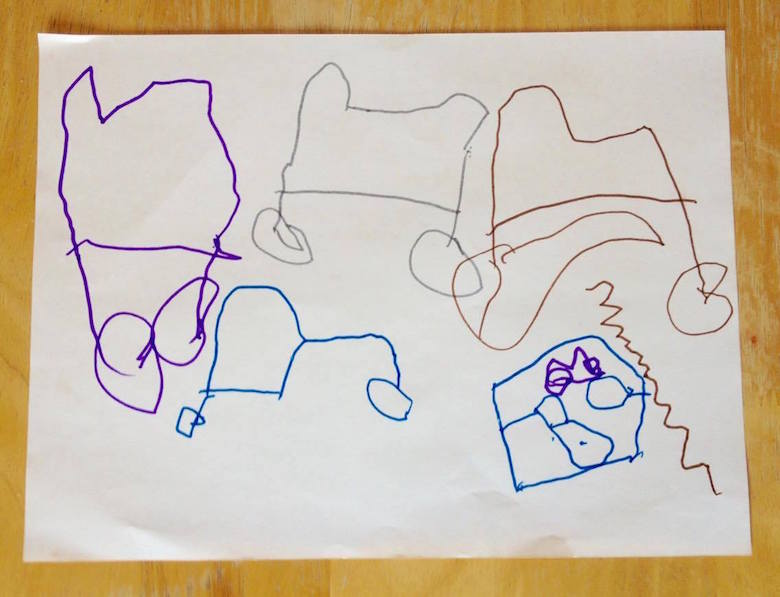
Isaiah grins at me across the dining room table and more than 1,000 miles.
In my nephew’s small, pale hand is an outsized Crayola marker, to match the pencil in my more gnarled fingers. We both lean over rectangles of paper—his in Colorado, mine in Oregon, now occupying the same virtual space, thanks to a slightly jumpy Skype connection.
My brother pops into the frame, revealing a bushy beard that he didn’t have when I saw him over Thanksgiving. “What’s another thing that you remember from our walks?” he asks Isaiah, who is four and half. Isaiah thinks for a minute and announces, “The brown truck!” He takes a moment to scribble on the paper, then holds it up for Patrick and me to admire.
I had asked Isaiah and my other family members in Boulder to help me with a basic experiment: Draw a map of the neighborhood where my parents have lived for decades, where my brother and I spent the first 18 years of our lives, and where Isaiah lived for a time with my brother while he was looking for a new apartment. But instead of being a regular map, with meticulously labeled streets and platted homes, drawn to scale and placed in context with relevant landmarks, my instructions were simply for each of us to identify the five most memorable things from the neighborhood that come to mind, and situate them in space in relation to my parents’ house.
In Topophilia—literally, love of place—Yi-Fu Tuan’s 1974 book on the way people relate to their environment, there is a chapter on ethnocentrism and space. In early maps and mapping experiments, cultures from across the globe have tended to place themselves and their known home landscape at the center of the world. Surrounding landmasses are secondary, smaller, distorted, or don’t exist at all—giving way to sea, or more mystical conceptions of what lay beyond it.
Might the same be true of us as distinct individuals, I wondered, each our own little countries with separate interests and histories? And would these little memory maps reveal a flicker of how we had experienced the same place differently?
Isaiah’s priorities are immediately clear, and clearly his own. This is the fourth truck he’s drawn, all of them bubble-fendered hulking classics that belong to neighbors, save for an old remote-controlled monster truck of my brother’s that Isaiah plays with on visits to my folks’ place. His fifth item is “the secret stairs” – a long concrete flight that connects a lower street with our street and feels clandestine because it threads between fenced yards. The overall effect is a house dwarfed by an army of benevolent colorful machines, with a well-marked escape route.
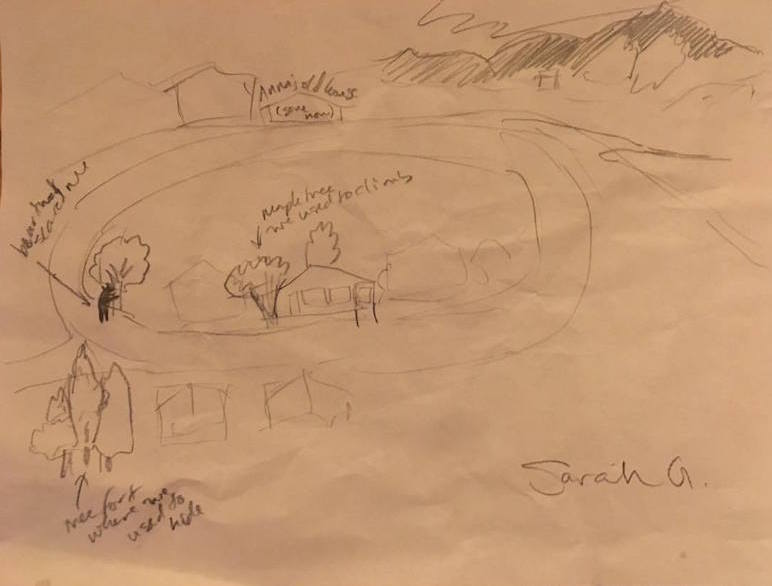
My own map, as you might expect, reflects a much longer timeframe. It is dominated by the homes of childhood friends I no longer see, some of which are no longer standing, and by trees. There are the three tall spruces that grew in a cluster that formed a sort of fort on one corner, where we laid a roll of red shag carpeting over the dusty needles. There is a maple tree in our front yard that had broad, low branches ideal for climbing. There is a maple down the street that a mother black bear leaped into as we watched one evening, two years ago. At midnight the same night, she charged me in my folks’ front yard when I took my dog out to pee.
In his own map, my brother ends up sketching out the once-undeveloped swath of our mesa where the ruins of a fish farm used to be, and where he found a cougar-killed deer once – a story that looms large in the mythology of his childhood. There’s a big red anthill he poked with sticks, the place where he broke his arm, a yard where he dove for Frisbees with a friend.
Later, in their maps, my mom and dad both mark the route of their shared morning walks and birdwatching, and choose different nearby landmarks as important – “church” and “food” for my dad, and the local shopping center, where we used to shop for craft supplies and ice cream, for my mom. Where dad’s map is populated with intriguing, cyclical abstracts — hawks and hawks, deer and deer, bears and bears and an unexpected and lovely reference to the rising moon, mom goes into meticulous detail on neighbors drinking wine while watching a wildfire, and her own “snow measuring” – a gentle allusion to the fact that she’s long used our neighborhood as a lab for home science experiments, such as testing whether temperature and the rate of cricket chirps are related.
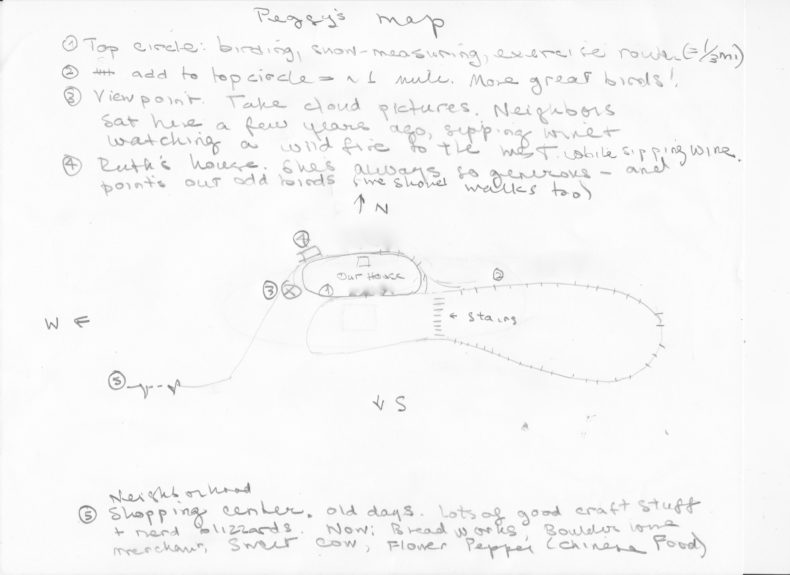
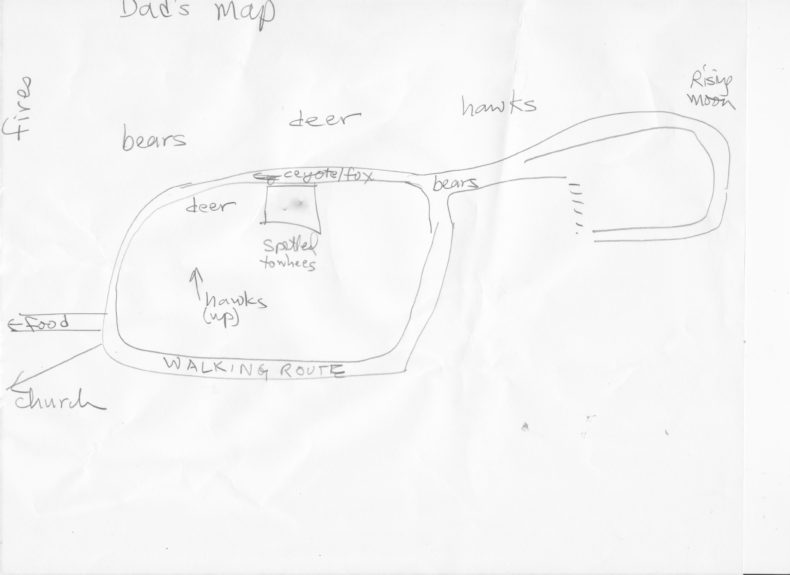
It occurs to me that mom’s home experiments aren’t so different than what I’m undertaking now. So it is that what I come away with is less a vision of our differences than it is a glimpse into the ways we’ve deeply influenced each others’ experience of this patch of ground.
My mom and I turn out to share as one of our top five the viewpoint at the end of the block where you can see dramatic clouds and the Front Range foothills, with their iconic slanted stone Flatirons. Her own love of mountains helped breed mine, and we both spent our 20s in their thrall, hiking, climbing, camping. But it is my brother’s map that offers the most striking example.
Perhaps because he finished it on his 45-minute bus ride to work, he’s wildly blown past the limits of the assignment (cheater!), labeling our old schools and a local rec center, in addition to his own top five. His map also includes every single one of Isaiah’s five notable landmarks, this corner of my brother’s life recast by this small, joyful person he’s raising—the way Isaiah sees the world, threading through Patrick’s own vision of it.
“I had to put Z’s trucks on the map because they totally dominate my experience of the neighborhood today,” he explains after texting me a photograph of his map. “I’m sure I wouldn’t have put them on if he weren’t into them.”
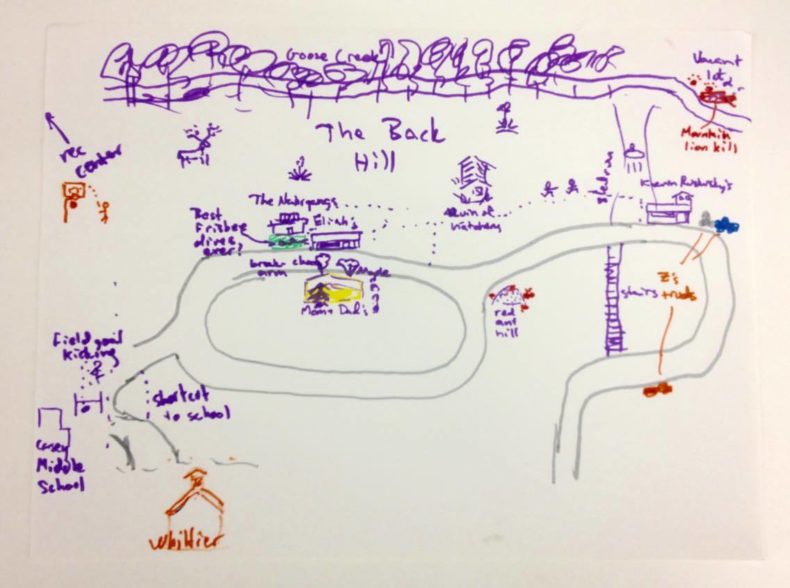
Sarah, I love this. It reminds me of the memory experiment I did with my own family: https://www.lastwordonnothing.com/2016/11/03/12132/. It’s not the same but in some way I can’t figure out, it is.
Oh yeah! It’s totally the same in the sense that we use a common experience or thing to gauge differences in perception. The difference seems to be that yours focuses on memory and its fallibilities and mine focuses on place-mapping as an expression of identity, I think?
I think you’re right. I wonder whether, if stretched enough, memory differences are also an expression of identity. I feel like there’s some big idea in here my brain isn’t quite big enough to get around.
I think definitely yes on that. The memories we recall are so contingent on the stories we tell to ourselves and others about the subject of that recollection. So I think they’re a deep part of our identity. Which, I suppose, only makes those memories even less likely to be accurate. As my brother wrote to me about his deer kill (which I’ve personally never totally believed belonged to a mountain lion…shhh) — “The back hill still is my deepest association with the neighborhood from when we were kids, but I haven’t been back there in close to 25 years so I’m not even sure how much time I spent back there, only that I have some really deep memories (eg of the carcass and tracks we found). The stories we tell or that we tell ourselves over and over are the ones that stick in front (and maybe the ones most altered by the telling!)”
The wicked imp if irreverence makes me want to scratch a copy of Isaiah’s map onto a rock and wait for someone to interpret it as evidence of paleolithic alien visitations.